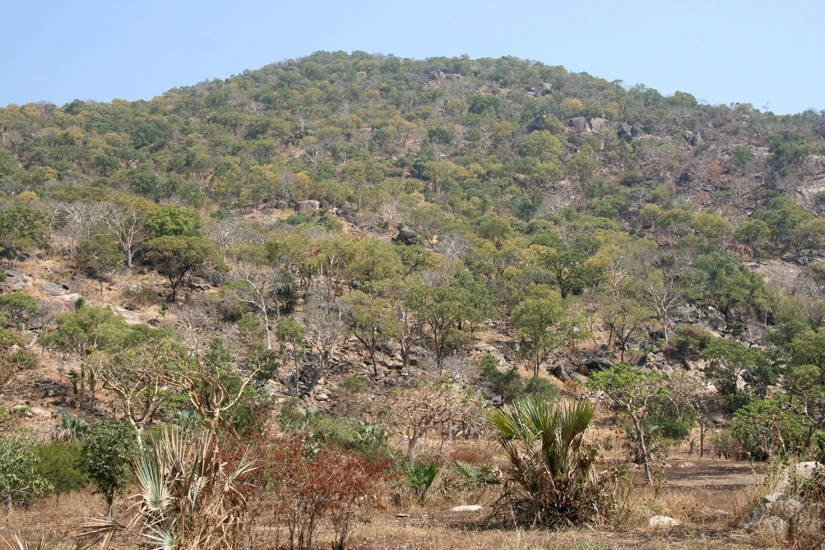
Useful Tree Species for Eastern Africa
a species selection tool based on the VECEA Map
Combretum wooded grassland (Wc)
Description
Trapnell and Langdale-Brown (1972 p. 133) mention that Combretum wooded grassland is the major wooded grassland vegetation type of East Africa (Kenya, Tanzania and Uganda). In these Combretum wooded grasslands, various broad-leaved Combretum species are associated with larger-leaved species of Terminalia (another species of the Combretaceae botanical family; Terminalia has two-winged woody fruits, whereas Combretum has four-winged woody fruits) in wetter areas, and with smaller-leaved Terminalia species in drier areas.
In the VECEA region, we mapped two subtypes of Combretum wooded grassland: dry Combretum wooded grassland (Wcd) and moist Combretum wooded grassland (Wcm). In areas of the VECEA region that occur in the Zambezian floristic region, we reclassified Combretum wooded grassland communities as subtypes of North Zambezian undifferentiated woodland (Wn; see also Box 1 in Volume 3).
I. Friis and Sebsebe Demissew 2008; Figure 4.2 in VECEA Volume 3
Conservation status
See the tables of dry Combretum wooded grassland (Wcd) and moist Combretum wooded grassland (Wcm).
Links
Species selection tool
Other vegetation types
//vegetationmap4africa.org
Documentation
Citation and terms of use
Click here for the full terms of use, disclaimer and errors and omissions statement that accompanies our data. When using our data, you agree with these terms.
Citation
Kindt R, van Breugel P, Orwa C, Lillesø JPB, Jamnadass R and Graudal L (2015) Useful tree species for Eastern Africa: a species selection tool based on the VECEA map. Version 2.0. World Agroforestry Centre (ICRAF) and Forest & Landscape Denmark. //vegetationmap4africa.org
van Breugel P, Kindt R, Lillesø JPB, Bingham M, Demissew S, Dudley C, Friis I, Gachathi F, Kalema J, Mbago F, Moshi HN, Mulumba, J, Namaganda M, Ndangalasi HJ, Ruffo CK, Védaste M, Jamnadass R and Graudal L (2015) Potential Natural Vegetation Map of Eastern Africa (Burundi, Ethiopia, Kenya, Malawi, Rwanda, Tanzania, Uganda and Zambia). Version 2.0. Forest and Landscape (Denmark) and World Agroforestry Centre (ICRAF). URL: //vegetationmap4africa.org
van Breugel P, Kindt R, Lillesø J-PB, van Breugel M (2015) Environmental Gap Analysis to Prioritize Conservation Efforts in Eastern Africa. PLoS ONE 10(4): e0121444. doi:10.1371/journal.pone.0121444
Terms of use
1) The data and tools on //vegetationmap4africa.org can be freely downloaded and used for educational, conservation and research purposes.
2) The recipient of the data will provide a full and appropriate acknowledgement and citation (see above) in any materials or publications derived in part or in whole from the data. For any publications making substantial use of the data, the VECEA team welcome the opportunity for coauthorship, collaboration and to comment prior to publication. Expressions of interest can be send using the contact form.
3) Reproduction of the dataset or products derived from it, either whole or in part, for commercial purposes is prohibited without prior written permission of the VECEA team. For the purposes of these Terms of Use, "commercial purposes" means a) any use by, on behalf of, or to inform or assist the activities of, a commercial entity (an entity that operates "for profit") or b) use by any non-profit entity for the purposes of revenue generation. If you require permission please email info@ecodiv.org
4) The recipient will not pass the original datasets on to third parties and will direct all requests for use of the data back to //vegetationmap4africa.org.
5) The recipient will not publish the data in their original format, either whole or in part, on a website, FTP site, CD, memory stick or any other media. The recipient should provide a link to the original data source location on the //vegetationmap4africa.org website where appropriate.
6) The recipient may only pass on datasets derived from these maps if the derived data are supplied with the same terms of use.
7) Use of these data does not constitute endorsement by the VECEA team or its partners of any derived products, reports or analyses.
8) The data are provided with additional supporting metadata, describing how they were compiled, ownership, type and quality of data, and limitations. The recipient must read all supporting information prior to any analysis and agree to abide by any stipulations contained therein. We cannot accept responsibility for the consequences of errors or omissions in the data, for misuse of the data by any organisation or individual, or for any damage done to computing systems into which the data are entered (see Disclaimer below).
9) The VECEA team will be informed about any products published using these data
Disclaimer
The VECEA team and its partners make no warranties or representations, express or implied, regarding the use of the material appearing in this dataset with regard to their correctness, reliability, accuracy, or otherwise. The material and geographic designations in this dataset do not imply the expressions of any opinion whatsoever on the part of the VECEA team, the Copenhagen University or the World Agroforestry Center concerning the legal status of any country, territory or area, nor concerning the delimitation of its frontiers or boundaries. The VECEA team, the Copenhagen University nor the World Agroforestry Center shall be responsible or liable to any person, firm or corporation for any loss, damage, injury, claim or liability of any kind or character based on or resulting from any information contained in the dataset.
Errors and omissions
The VECEA team endeavour to maintain accurate and up-to-date data at all times. However, if errors or omissions are identified, the user should notify the VECEA team so that they can be corrected in future releases of the data. Users can contact the VECEA team using the contact form.



